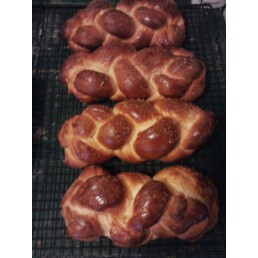Alleluia! The bread is risen.
Saturday, 23 April 2011 § Leave a comment
Well, that was… I don’t even know what it was. It’s over, is the main thing. The exam was a four-hour timed sit-down — thankfully, I was allowed to write on my own computer. Four questions: choose one from the first two and one from the second. I had somewhat anticipated variants of two of them, and felt like I could have answered the third, too. And as for the fourth… well… let’s just say it’s a good thing that I have a week to keep studying between my last exam and the orals. It’s a question I should be able to answer, but, well, I’m glad I could choose not to. The exam itself wasn’t as bad as I thought it would be, but I was still pretty much useless for the rest of the day. I came home, put on my PJ’s, poured a glass of wine, and watched crappy internet television.
The last exam starts Monday, though part of it is a syllabus I’ve technically been working on for while. And I’m using technically in a very loose sense there. You know, kind of like how everything’s a “technology” now, where it used to be a “discourse” (or ruin, or trace, or topos): books, knowledge, Being, etc. Add to that list: thinking but not actually working. Whee.
As you all know by now, my MO is stress baking. And so this morning, I mixed up a batch of Austrian Easter Bread (Osterbrot). Last year my friend and upstairs neighbor invited me to his Easter brunch, and I made a couple of loaves of his mom’s Osterbrot. Here’s last year’s:
Each of those was a full batch of dough; this year, I’ve made one batch and divided it into four loaves because y’all, that is a lot of Brot.
The bread itself is very similar to a Challah dough: enriched, yeast-leavened, but minus the eggs in the dough. Want the recipe? Here it is. Just don’t tell my dear neighbor that I’m giving away his heirloom, kthanks.
1 Kilo All-purpose four
100 g softened butter
200 g Sugar (or less for a less-sweet bread)
1 tsp salt
½ L Milk
30 g fresh yeast or. 2 Packets active dry yeast
Spices: anise (fennel if you can’t find star anise); zest of one lemon
Optional addition: raisins
Add the anise and lemon zest to the milk and heat gently in a saucepan. Turn off heat, and leave to cool and steep, approximately half an hour or until milk is lukewarm. Transfer the milk to a mixing bowl and sprinkle the yeast over it. Let the yeast proof approx. 15 minutes. Then add 3/4 of the flour, the salt, and the sugar. mix until it forms a rough dough. Then add the softened butter in chunks. Add the last of the flour (and raisins, if you’re using them), and knead either by hand or with a stand mixer until smooth and elastic.
Place the dough in a large bowl, cover with plastic wrap or a light towel, and place in a warm place to rise (mine likes to rise on top of my stove). Let rise until doubled, gently punch down, and let it rise until doubled again. Since this dough is full of yeast and is sugary, the rise will be really fast. I had to run down to the store [damn you, clogged drains] during the second rise today, and was gone for maybe an hour; when I came back, the dough had nearly tripled.)
Turn the dough out onto a lightly floured surface. Again, one batch of this makes a HUGE loaf, so I suggest you divide it. Two, three, or four loaves would be fine. So divide your dough into X sections, where x = the number of loaves you wish to make. Now: decide if you’re going to do a three or four-strand braid (I did 4, but I think 3 is traditional for Easter, you know, with the trinity and whatnot). Then, divide each section into 3 (or 4) subsections and roll each out into a rope approximately 1 inch wide. Mine ended up being about a foot long. Then braid them. And repeat for each of your X sections.
Place the loaves on a baking sheet lined either with parchment paper or a Silpat. Let them rise again for about an hour, maybe longer, until approximately doubled. It doesn’t have to be exact. When you figure they’re about ready, preheat your oven to 350 (F). Beat an egg and smear it on top of the loaves, then, if you’re feeling really fancy, sprinkle some turbinado or raw sugar on top. Bake the loaves until deep golden brown on top. Since my oven is heart-breakingly small, I baked them two at a time. For one large loaf, this will be about an hour; for smaller ones, start checking them at half an hour. If you find that the top is getting very dark but the crumb isn’t baked all the way through yet, lower the temperature to 300. Cool on a rack. Then nom. If the bread lasts long enough to go stale, breads like this make a decadent french toast. (Just sayin’.)
Really, this is a super-easy recipe, and a great bread recipe to start with if you’re convinced that you in fact cannot bake bread to save your life. Trust me. It’s really, really hard to screw this one up.
So, now that the bread is risen, so are my spirits, and I’m off to conquer this syllabus. Onward-ho!



